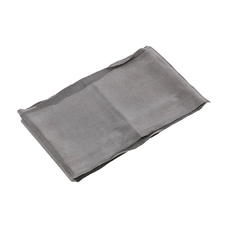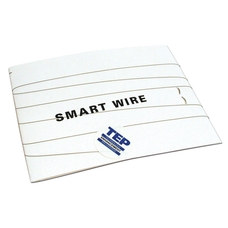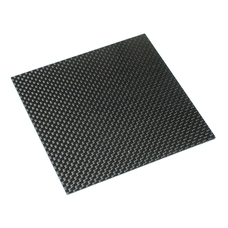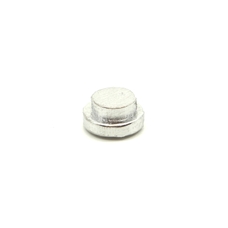Mixed Smart Materials Collection
Mixed Smart Materials Collection
Product code: HP054651
Product Description
Our Smart Materials Collection contains 15 different examples of Smart Materials all housed inside a Gratnells Tray for easy storage. Conduct a whole host of different demonstrations of Smart Materials using our kit including UV Reactive beads, smart fabrics, metals, paints and polymers.
The Collection contains:
- UV Detecting Beads Pack of 250
A bag of white beads which turn into many different colours when exposed to an ultraviolet light source. Ideal for observing UV radiation from the Sun. A great way to raise awareness of the health issues associated with exposure to the sun. A science activity guide is included and allows students to carry out scientific investigations and learn about the effects of the sun on their health.
- Photochromic Pigment: Orange 3g
These pigments normally have a pale, off-white appearance but in sunlight or UV light they change to a bright, vivid colour. The pigments revert to their pale colour when away from sunlight or UV light. Methods of application include brush painting, block printing, stencilling, screen printing etc.
- Chameleon Nano Flakes 5g
This material consists of nano-size silicon flakes each covered with a titanium compound. The flakes have amazing light scattering properties if mixed with clear varnishes or polymers. An object thus coated will change colour completely according to the viewing angle. Please note: this small quantity covers a huge area as a surface finish.
- Kevlar Woven Fabric 250mm x 250mm
Kevlar has many applications, ranging from bicycle tyres and racing sails to body armour because of its high strength-to-weight ratio. Famously 5 times stronger than steel on an equal weight basis.
- Polymorph: Malleable Smart Polymer 500g
Polymorph is one of a new generation of polymers set to have a major impact on model making and prototyping. This polymer has all the characteristics of a tough 'engineering' material yet it softens and becomes easily mould-able at just 62°C. It can be heated with hot water or a hairdryer and can then be moulded by hand to create prototypes and solve manufacturing problems currently outside the capacity of other materials. Polymorph is reusable and the material can be coloured when soft by adding a small amount of food dye.
- Thermocolour Sheet 20 to 25°C 150 mm x 300 mm
These thermochromic sheets change colour when influenced by changes in temperature provide an exciting way to see thermal mapping changes through colour. The sheets can be used to demonstrate, Conduction, Insulation, Convection, Radiation and Friction, and other experiments involving temperature change. The colour changes are reversible and on cooling the colour change sequence is reversed. Sheet can be cut to size.
- Smart Putty 100g
Smart putty has been available for a long time as an amusement, but this visco-elastic polymer has serious engineering applications. Soft, stretchy and bendy when moved slowly, solid when trying to move quickly or impacted. It has the remarkable property that it usually behaves as a soft mould-able plastic (like chewing gum), but instantly becomes a rubber if impacted and bounces like a ball. It can also float in a liquid and will form a puddle given enough time. It is a great demonstration of an unusual polymer, a useful adhesive and can be used in many creative and fun activities.
- Hydrochromic Paint 50ml
Hydrochromic pigments change colour when exposed to water. This version is a reversible pigment which works by forming an opaque film that covers a coloured image or pattern. When the film is exposed to water it becomes transparent and reveals what is hidden underneath - thus appearing to change colour. As the film dries it returns to it's opaque state and covers up the image or pattern.
- Electrolycra Strip
This material looks and feels like ordinary Lycra but is highly conductive. It can be cut into narrow strips to form conducting 'wires' or can be used as a soft compliant substitute for metal and foil in switches and sensors. Amazingly, its conductivity depends how tightly it is stretched so if you pull it, the resistance increases (and drops again when stretched very tightly). In a thin strip, the material also warms up when current is passed thus provides the basis of a heated garment or product such as a hat or gloves.
- Hydrogel 500g
This completely non-toxic powder absorbs up to 500 times its own weight in water and is the 'secret' ingredient used in applications ranging from babies nappies to perpetual growing plants. When exposed to water, the powder transforms into a gel which holds the water for an extended period. Placing a small pile of Hydrogel in the centre of a Petri-dish, adding drops of water from a syringe or pipette causes the Hydrogel to swell until it can absorb no more water. This can be a simple quantitative experiment by weighing before and after water absorption.
- Genuine Carbon Fibre Sheet 100mm x 100mm x 0.5mm
This ultra-smooth sheet material is a aerospace quality carbon-fibre reinforced composite. Because of its combination of low mass and extraordinary strength, its uses range from spacecraft fabrication to formula 1 racing cars. It is also a highly attractive material and suitable for small–scale prestige work. This is one of the few modern engineering materials, along with titanium, favoured by ‘new wave’ jewellers. The sheet can be cut on a suitable guillotine and shaped with conventional tools.
- Fields Metal 10g (*Teacher Demonstration Only*)
This remarkable alloy melts at just 61°C, but does not contain lead or cadmium. It is relatively hard and extremely tough. Fields metal makes a fantastic demonstration of how several constituents, each with a much higher melting point, can be combined to produce a useable alloy. Demonstration use is recommended - Indium is a potentially toxic material if ingested. Before using a risk assessment should be carried out.
- Chromatic Alginate - 450g
Made from seaweed, this remarkable material is used in dentistry to make precision moulds in the mouth for crown construction etc. When the fine white powder is mixed with water, it turns purple and then changes colour to indicate readiness for moulding around a pattern – and then setting. The material is entirely natural and non–toxic, and has a very low cost compared to materials such as silicon compounds.
- Graphite Levitation Kit
This kit contains a small sample of pyrolytic graphite, 16 small rare earth magnets, a steel base and a pair of tweezers. When the magnets are arranged in a matrix on the base plate, the graphite will levitate just above the surface. This is a spectacular demonstration of diamagnetic behaviour involving repulsion of the graphite by both the N and S poles of the magnets.
- Polyox: The Self Siphoning Liquid - 50g
Polyethylene oxide in a non-toxic, long-chain polymer with a high molar mass. Because of extensive hydrogen bonding, it is soluble in water. A solution of Polyox (approximately 1% w/v) behaves as an 'elastic liquid' and it 'self-siphons'. If you quickly drag some of the solution from a beaker with a spatula or spoon, it will continue to move out of the beaker.
- Deep Gratnells Tray - Blue
- A comprehensive demonstration kit which can be used to introduce and demonstrate a wide range of Smart Materials.
- Also useful to aid in the discussion of the everyday uses of Smart Materials.
- Cross applications in Science, Design Technology and Art classes.
- Key Stage 3 Chemistry - Materials: Properties of ceramics, polymers and composites (qualitative)
- Key Stage 4 Chemistry - Structure, Bonding and the Properties of Matter: Smart Materials and Their Properties. Bulk properties of materials related to bonding and intermolecular forces
- Risk Assessment and Safety Data should always be observed when using the Smart Materials contained in this kit.
- Supplier Datasheets are available on request.
- Fields Metal must be used for teacher demonstrations only.
- Care should always be taken when using rare Earth magnets - these should be counted into and out of the classroom.
- All items are also available to purchase separately.
Further Information
- Activation Method
- HeatLight & UVElectricity/VoltageLiquidMagnetismMovement
- Age Recommended from
- 11 Years
- Age Recommended to
- 18 Years
- Age Suitable from
- 3 Years
- Brand
- Unbranded
- Curriculum Link
- Smart Materials
- Material Type
- Mixed
- Product Type
- Smart Materials
Our Smart Materials Collection contains 15 different examples of Smart Materials all housed inside a Gratnells Tray for easy storage. Conduct a whole host of different demonstrations of Smart Materials using our kit including UV Reactive beads, smart fabrics, metals, paints and polymers.
The Collection contains:
- UV Detecting Beads Pack of 250
A bag of white beads which turn into many different colours when exposed to an ultraviolet light source. Ideal for observing UV radiation from the Sun. A great way to raise awareness of the health issues associated with exposure to the sun. A science activity guide is included and allows students to carry out scientific investigations and learn about the effects of the sun on their health.
- Photochromic Pigment: Orange 3g
These pigments normally have a pale, off-white appearance but in sunlight or UV light they change to a bright, vivid colour. The pigments revert to their pale colour when away from sunlight or UV light. Methods of application include brush painting, block printing, stencilling, screen printing etc.
- Chameleon Nano Flakes 5g
This material consists of nano-size silicon flakes each covered with a titanium compound. The flakes have amazing light scattering properties if mixed with clear varnishes or polymers. An object thus coated will change colour completely according to the viewing angle. Please note: this small quantity covers a huge area as a surface finish.
- Kevlar Woven Fabric 250mm x 250mm
Kevlar has many applications, ranging from bicycle tyres and racing sails to body armour because of its high strength-to-weight ratio. Famously 5 times stronger than steel on an equal weight basis.
- Polymorph: Malleable Smart Polymer 500g
Polymorph is one of a new generation of polymers set to have a major impact on model making and prototyping. This polymer has all the characteristics of a tough 'engineering' material yet it softens and becomes easily mould-able at just 62°C. It can be heated with hot water or a hairdryer and can then be moulded by hand to create prototypes and solve manufacturing problems currently outside the capacity of other materials. Polymorph is reusable and the material can be coloured when soft by adding a small amount of food dye.
- Thermocolour Sheet 20 to 25°C 150 mm x 300 mm
These thermochromic sheets change colour when influenced by changes in temperature provide an exciting way to see thermal mapping changes through colour. The sheets can be used to demonstrate, Conduction, Insulation, Convection, Radiation and Friction, and other experiments involving temperature change. The colour changes are reversible and on cooling the colour change sequence is reversed. Sheet can be cut to size.
- Smart Putty 100g
Smart putty has been available for a long time as an amusement, but this visco-elastic polymer has serious engineering applications. Soft, stretchy and bendy when moved slowly, solid when trying to move quickly or impacted. It has the remarkable property that it usually behaves as a soft mould-able plastic (like chewing gum), but instantly becomes a rubber if impacted and bounces like a ball. It can also float in a liquid and will form a puddle given enough time. It is a great demonstration of an unusual polymer, a useful adhesive and can be used in many creative and fun activities.
- Hydrochromic Paint 50ml
Hydrochromic pigments change colour when exposed to water. This version is a reversible pigment which works by forming an opaque film that covers a coloured image or pattern. When the film is exposed to water it becomes transparent and reveals what is hidden underneath - thus appearing to change colour. As the film dries it returns to it's opaque state and covers up the image or pattern.
- Electrolycra Strip
This material looks and feels like ordinary Lycra but is highly conductive. It can be cut into narrow strips to form conducting 'wires' or can be used as a soft compliant substitute for metal and foil in switches and sensors. Amazingly, its conductivity depends how tightly it is stretched so if you pull it, the resistance increases (and drops again when stretched very tightly). In a thin strip, the material also warms up when current is passed thus provides the basis of a heated garment or product such as a hat or gloves.
- Hydrogel 500g
This completely non-toxic powder absorbs up to 500 times its own weight in water and is the 'secret' ingredient used in applications ranging from babies nappies to perpetual growing plants. When exposed to water, the powder transforms into a gel which holds the water for an extended period. Placing a small pile of Hydrogel in the centre of a Petri-dish, adding drops of water from a syringe or pipette causes the Hydrogel to swell until it can absorb no more water. This can be a simple quantitative experiment by weighing before and after water absorption.
- Genuine Carbon Fibre Sheet 100mm x 100mm x 0.5mm
This ultra-smooth sheet material is a aerospace quality carbon-fibre reinforced composite. Because of its combination of low mass and extraordinary strength, its uses range from spacecraft fabrication to formula 1 racing cars. It is also a highly attractive material and suitable for small–scale prestige work. This is one of the few modern engineering materials, along with titanium, favoured by ‘new wave’ jewellers. The sheet can be cut on a suitable guillotine and shaped with conventional tools.
- Fields Metal 10g (*Teacher Demonstration Only*)
This remarkable alloy melts at just 61°C, but does not contain lead or cadmium. It is relatively hard and extremely tough. Fields metal makes a fantastic demonstration of how several constituents, each with a much higher melting point, can be combined to produce a useable alloy. Demonstration use is recommended - Indium is a potentially toxic material if ingested. Before using a risk assessment should be carried out.
- Chromatic Alginate - 450g
Made from seaweed, this remarkable material is used in dentistry to make precision moulds in the mouth for crown construction etc. When the fine white powder is mixed with water, it turns purple and then changes colour to indicate readiness for moulding around a pattern – and then setting. The material is entirely natural and non–toxic, and has a very low cost compared to materials such as silicon compounds.
- Graphite Levitation Kit
This kit contains a small sample of pyrolytic graphite, 16 small rare earth magnets, a steel base and a pair of tweezers. When the magnets are arranged in a matrix on the base plate, the graphite will levitate just above the surface. This is a spectacular demonstration of diamagnetic behaviour involving repulsion of the graphite by both the N and S poles of the magnets.
- Polyox: The Self Siphoning Liquid - 50g
Polyethylene oxide in a non-toxic, long-chain polymer with a high molar mass. Because of extensive hydrogen bonding, it is soluble in water. A solution of Polyox (approximately 1% w/v) behaves as an 'elastic liquid' and it 'self-siphons'. If you quickly drag some of the solution from a beaker with a spatula or spoon, it will continue to move out of the beaker.
- Deep Gratnells Tray - Blue
- A comprehensive demonstration kit which can be used to introduce and demonstrate a wide range of Smart Materials.
- Also useful to aid in the discussion of the everyday uses of Smart Materials.
- Cross applications in Science, Design Technology and Art classes.
- Key Stage 3 Chemistry - Materials: Properties of ceramics, polymers and composites (qualitative)
- Key Stage 4 Chemistry - Structure, Bonding and the Properties of Matter: Smart Materials and Their Properties. Bulk properties of materials related to bonding and intermolecular forces
- Risk Assessment and Safety Data should always be observed when using the Smart Materials contained in this kit.
- Supplier Datasheets are available on request.
- Fields Metal must be used for teacher demonstrations only.
- Care should always be taken when using rare Earth magnets - these should be counted into and out of the classroom.
- All items are also available to purchase separately.
Further Information
- Activation Method
- HeatLight & UVElectricity/VoltageLiquidMagnetismMovement
- Age Recommended from
- 11 Years
- Age Recommended to
- 18 Years
- Age Suitable from
- 3 Years
- Brand
- Unbranded
- Curriculum Link
- Smart Materials
- Material Type
- Mixed
- Product Type
- Smart Materials





